Ukraine crisis in maps
- Published
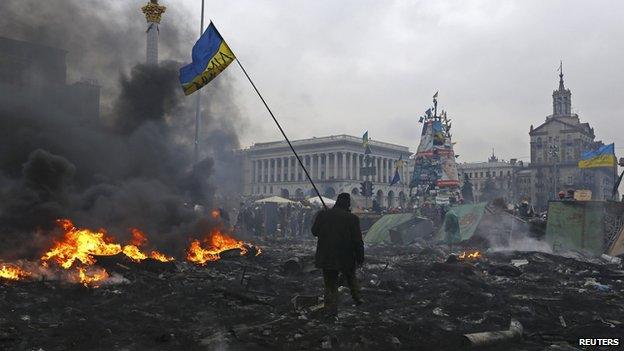
The crisis in Ukraine began in November 2013 when pro-Moscow President Viktor Yanukovych's government abandoned a deal with the European Union in favour of stronger ties with Russia.
Ukraine has been torn between east and west since the collapse of the Soviet Union in 1991. Ukrainian is the main language in western regions - where there is also a long-standing aspiration for integration with Europe. However, Russian is predominant in parts of the east and south.
2013 protests
Outraged by the move towards Moscow, anti-government demonstrations take place in Kiev with an estimated 100,000 on the streets. By December, some 800,000 people rally in the capital and protesters occupy city hall and Independence Square.
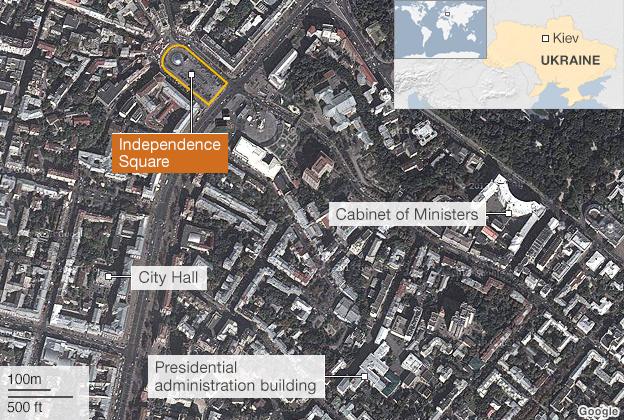
Protests spread
In mid-January, parliament passes restrictive anti-protest laws as clashes turn deadly. Anti-Yanukovych protesters begin storming regional government offices in other parts of western Ukraine.
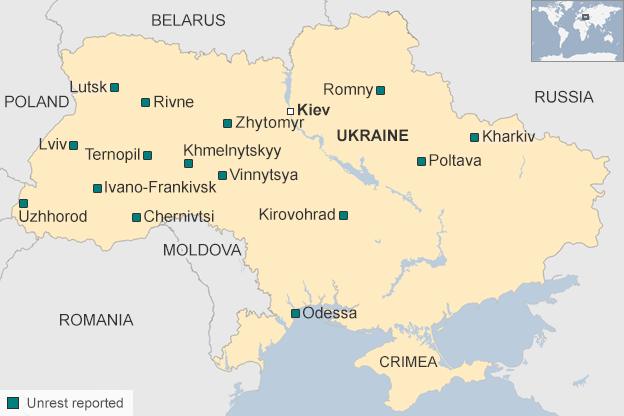
On 20 February, 2014, bloodshed reaches its worst since the start of the crisis. At least 88 people are killed in 48 hours in Kiev and hundreds wounded in clashes between protesters and police, including many shot by uniformed snipers. President Yanukovych disappears and protesters take control of government buildings.
Parliament votes to remove the president from power, with elections set for 25 May. The elite Berkut police unit, blamed for deaths of protesters, is disbanded. Parliament also votes to ban Russian as the second official language, triggering a wave of anger in Russian-speaking regions - although the vote is later overturned.
Crimea
On 27-28 February, pro-Russian gunmen seize key buildings in the Crimean capital, Simferopol. The majority of Crimea's 2.3 million population identify themselves as ethnic Russians and speak Russian - a legacy of Russia's 200-year involvement in the region. Sevastopol in Crimea is also the historic base of Russia's Black Sea Fleet.
Within days, the Crimean parliament votes to join Russia and calls a referendum. Russia later admits that its military helped the Crimea insurgents.

On 16 March, 97% of referendum voters reportedly back the proposal to join Russia. The figure is later disputed, with leaked documents showing only 50-60% support for the move.
The EU and US condemn the annexation of Crimea and impose a first round of sanctions on Russian officials and high-ranking Moscow allies in Ukraine.
Trouble spreads east
After Ukrainian troops withdraw from Crimea, there are reports of many Russian troops gathering in border areas adjacent to the eastern regions of Donetsk and Luhansk, Ukraine's industrial heartland.
On 7 April, protesters occupy government buildings in the eastern cities of Donetsk, Luhansk and Kharkiv.
Although Kharkiv is retaken the following day, the occupations spread to other cities, and a number of pro-Russian leaders declare that referendums on granting greater autonomy to eastern regions will be held.
Towns targeted by separatists, April 2014

Eastern referendums
On 11 May pro-Russian separatists in Donetsk and Luhansk declare independence as "people's republics" after the referendums, which were not recognised by Kiev or the West.

A build-up of Russian troops on the shared border in April sparks concern that another annexation could take place.
Presidential election
Elections for a new president in Ukraine are held on 25 May, resulting in confectionery tycoon Petro Poroshenko being elected with more than 55% of the vote, although no polling stations were open in Donetsk city and several other locations.

On 20 June, President Poroshenko announces a 15-point peace plan and declares a week-long truce. It holds for a few days until a military helicopter is shot down over eastern Ukraine.
With a government offensive launched once more, on 5 July rebels abandon strongholds in the north of Donetsk region, withdrawing to a smaller area of insurgency in the south.
Malaysia Airlines tragedy, 17 July 2014

On 17 July Malaysia Airlines flight MH17 from Amsterdam is shot down near the village of Grabove, in rebel-held territory close to the border with Russia.
The crash kills 298 people - everybody aboard the airliner. The Netherlands has the biggest death toll (196), then Malaysia (42) and Australia (27). Western nations blame a Russian-supplied missile, believed to have been fired by rebels.
Russia denies it had armed the rebels and argues instead that a Ukrainian fighter jet had flown near the airliner at the time.
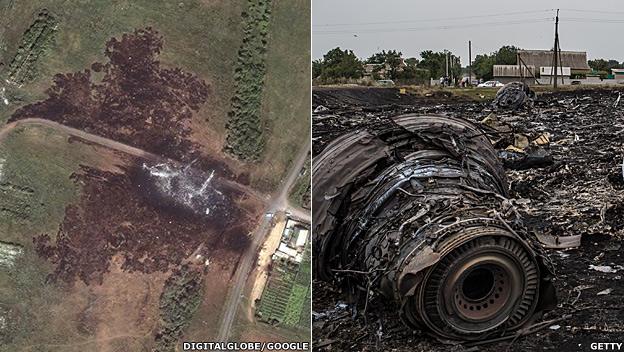
Satellite image shows plane debris littering a wide area near the village of Grabove
Ukraine insists Russian regular forces are involved in the fighting in Ukraine. It also accuses the Russian authorities of allowing well-trained volunteers and heavy weapons to cross the border to help the rebels. Russia dismisses those accusations, yet the rebel leader in Donetsk says many Russian soldiers have joined the rebel cause.
New front
Ukrainian forces make gains in some areas previously held by the rebels. But on 27 August the rebels - allegedly backed by Russian heavy armour - open up a new front on the coast, seizing the town of Novoazovsk and threatening the strategic port city of Mariupol.

Ceasefire
A ceasefire is agreed on 5 September between Ukraine and the pro-Russian rebels in the east. Signed in Minsk, Belarus, it is violated just four days later when fierce fighting erupts around Donetsk airport.
The battle for the airport continues with the Ukrainians remaining in control, although it is now so badly damaged that it is closed to flights.

Elsewhere in the east there are repeated violations of the truce. By 19 September, the rebels control a stretch along the Russian border to the coast.
Fresh elections
On 26 October Ukrainians vote for a new parliament. Pro-West parties triumph but the polls are boycotted in the rebel-held east - which goes on to hold its own elections on 2 November.
Two pro-Russian leaders are declared the winners - but President Petro Poroshenko immediately threatens to scrap a law (agreed under the 5 September truce) which gave special status to Donetsk and Luhansk.
Donetsk airport falls
In January 2015, fighting between the army and the rebels intensifies in and around Donetsk, as well as in Luhansk region. Both sides seem to be battling for new ground, keen to strengthen their negotiating positions ahead of any "peace summit".

On 22 January, Ukrainian forces withdraw from Donetsk airport's main terminal, after weeks of bitter fighting. The airport is strategically important. Government forces had been able to shell rebel positions inside nearby Donetsk - the largest city held by the militants.
There are fears its capture could help the rebels to resupply - allowing munitions, hardware and manpower to be airlifted into the conflict zone. But drone images of the airport taken in January show how devastated the terminal building is.
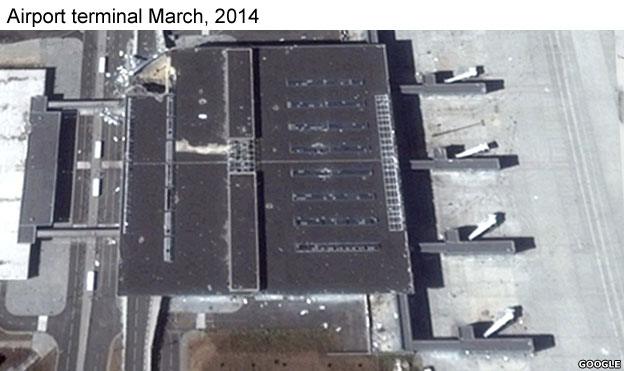
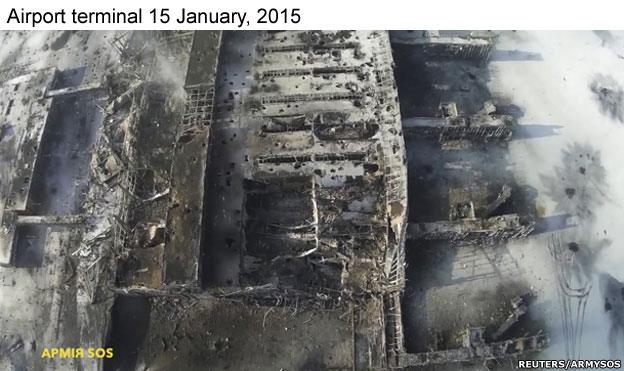
The rebels continue their offensive in February.

The fiercest fighting is near the town of Debaltseve, where the rebels are trying to surround Ukrainian troops. The town is a crucial rail hub linking Donetsk and Luhansk.
February diplomatic push
As clashes continue there is a renewed diplomatic push to end the fighting. Meanwhile, a truce allows civilians to leave Debaltseve.
On 12 February - after marathon talks in the Belarus capital, Minsk, an agreement is reached to end the fighting. The leaders of Russia, Ukraine, Germany and France announce that a ceasefire will begin on 15 February. The deal also includes weapon withdrawals and prisoner exchanges, but key issues remain to be settled.
The pro-Russian rebels in eastern Ukraine also sign the agreement which includes a buffer zone for heavy weapons, with a minimum of 50km (30 miles) between rival forces' artillery (140km for rockets).

Withdrawal from Debaltseve
Despite the ceasefire, heavy fighting continues around Debaltseve with rebel forces pressing to capture the strategically important road and rail hub, to join up territory held in Donetsk and Luhansk regions.
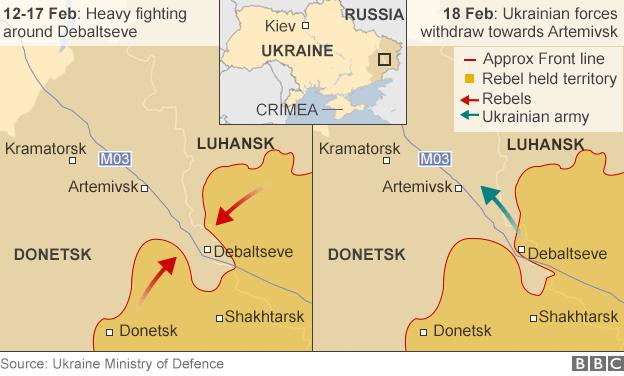
On 18 February, President Poroshenko announces that 80% of Ukrainian forces have pulled back from the town towards Artemivsk.
Eyewitnesses report dozens of tanks and columns of weary troops retreating, while a Russian TV station shows footage of what it says is a rebel flag being raised on a high-rise building in the town.